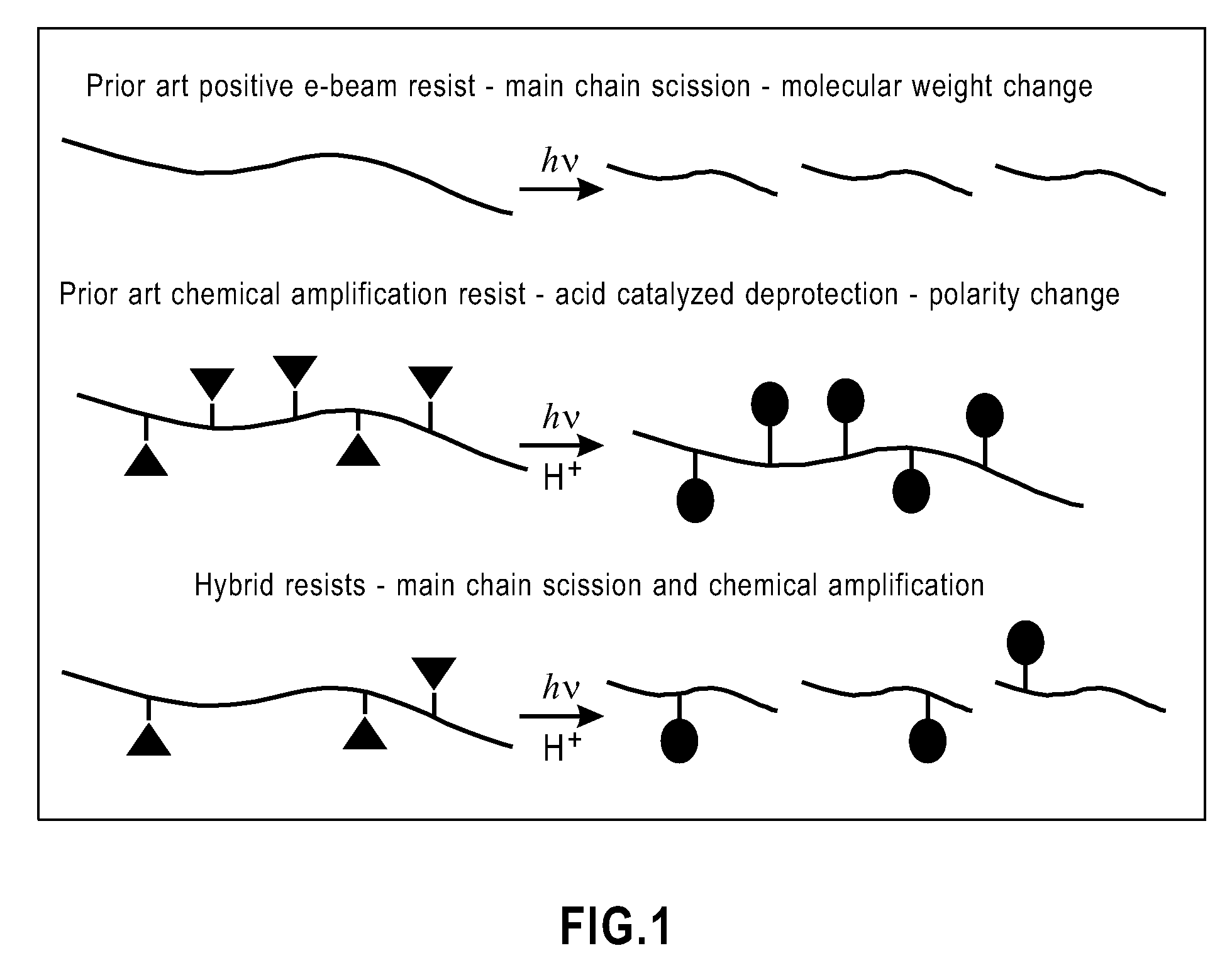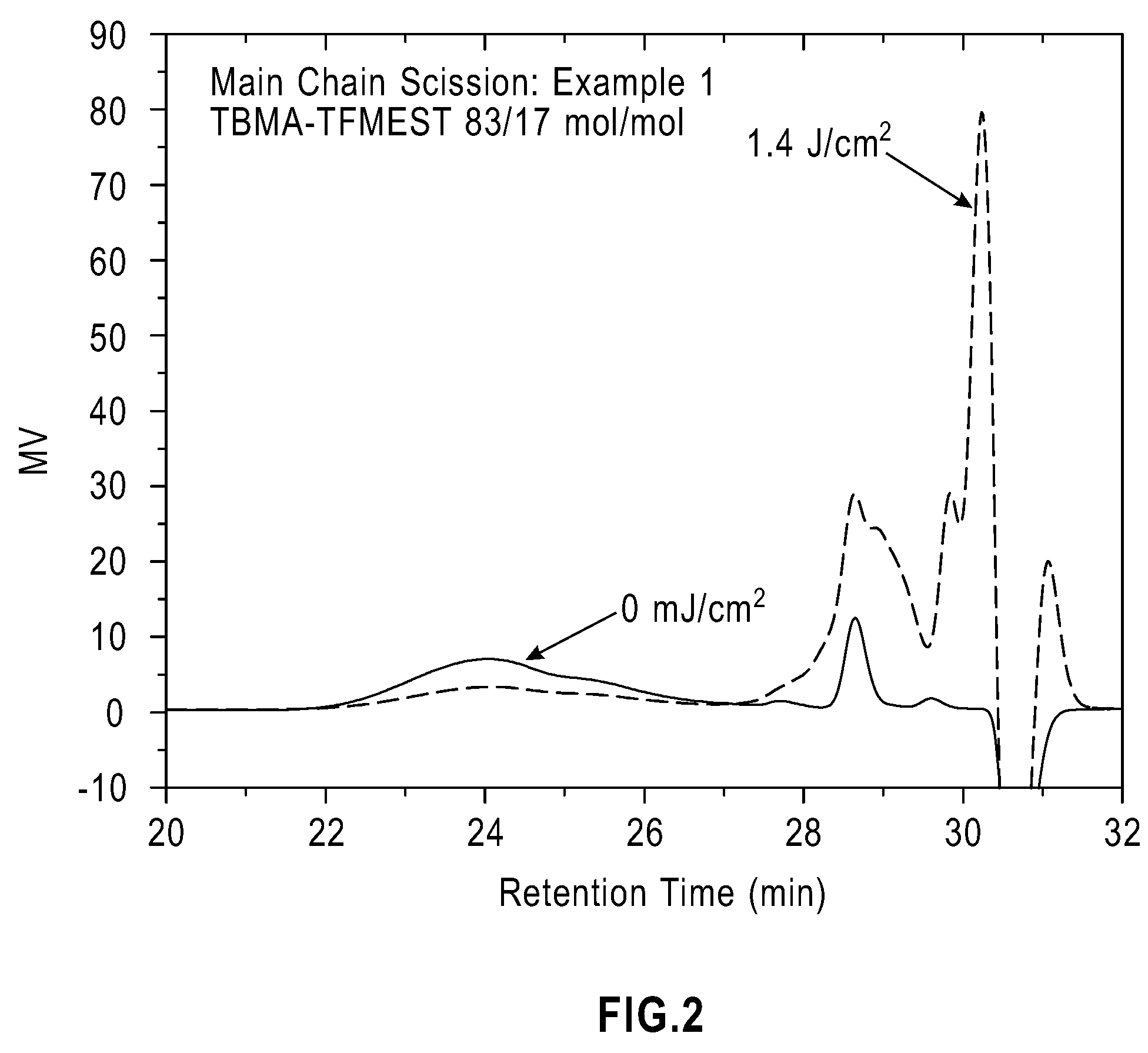Photoresist compositions and methods of use
a composition and composition technology, applied in the field of photoresist compositions, can solve the problems of low sensitivity of high-volume manufacturing, less soluble exposed portions, and questionable resolution capability below 30 nm
- Summary
- Abstract
- Description
- Claims
- Application Information
AI Technical Summary
Benefits of technology
Problems solved by technology
Method used
Image
Examples
example 1
TBMA-TFMEST (1:1 mol / mol in Feed)
[0105]A mixture of TBMA (2.8512 g), TFMEST (3.4429 g), and 2,2′-azobisisobutyronitrile (AIBN, 0.2634 g) was deaerated by bubbling N2 for 30 min and heated at 60° C. in a N2 atmosphere for 6 days 17 hrs. The resulting solid was dissolved in acetone and slowly poured into a mixture of methanol and water (3 / 1 vol / vol) and the precipitated polymer was isolated by filtration and washed with a methanol / water (3 / 1 vol / vol) mixture. The polymer was dried in a vacuum oven at 60° C. overnight, yielding 2.6456 g (42.0%) of white solid. The analyzed composition of the copolymer was TBMA / TFMEST=83 / 17 (mol / mol) according to inverse-gated 13C NMR in acetone-d6 using Cr(acac)3 as a relaxation agent. The number and weight average molecular weights relative to polystyrene standards, determined by GPC in THF, were Mn=3,500 and Mw=5,200. Its glass transition temperature (Tg) was 60° C.
example 2
TBTFMA-MEST (1:1 mol / mol in Feed)
[0106]A mixture of TBTFMA (19.628 g), MEST (11.850 g), and AIBN (1.3141 g) was deaerated by bubbling N2 for 30 min and heated at 60° C. in N2 for 3 days. AIBN (0.6416 g) was added and the heating was continued for another 4 days. The polymer was precipitated in methyl perfluoro-n-propyl ether, filtered, and washed with methyl perfluoro-n-propyl ether. After drying in a vacuum oven at room temperature overnight, the polymer yield amounted to 6.055 g (19%). The copolymer composition was TBTFMA / MEST=39 / 61 (mol / mol). Mn=1,400 and Mw=1,900.
example 3
TBMA-MEST (1:1 mol / mol in Feed)
[0107]A mixture of TBMA (5.6945 g), MEST (4.7339 g), and AIBN (0.2636 g) was deaerated by bubbling N2 for 30 min and heated at 60° C. in N2 for 7 days. The reaction mixture was diluted with acetone and poured slowly into methanol. The precipitated polymer was recovered by filtration and washed with methanol. The copolymer was dried in a vacuum oven at 60° C. overnight. The copolymer yield was 1.725 g (15%). Mn=8,100 and Mw=11,500. The composition was TBMA / MEST=57 / 43 (mol / mol) and its Tg was 144° C.
PUM
| Property | Measurement | Unit |
|---|---|---|
| wavelengths | aaaaa | aaaaa |
| wavelengths | aaaaa | aaaaa |
| temperatures | aaaaa | aaaaa |
Abstract
Description
Claims
Application Information
 Login to View More
Login to View More - R&D
- Intellectual Property
- Life Sciences
- Materials
- Tech Scout
- Unparalleled Data Quality
- Higher Quality Content
- 60% Fewer Hallucinations
Browse by: Latest US Patents, China's latest patents, Technical Efficacy Thesaurus, Application Domain, Technology Topic, Popular Technical Reports.
© 2025 PatSnap. All rights reserved.Legal|Privacy policy|Modern Slavery Act Transparency Statement|Sitemap|About US| Contact US: help@patsnap.com



